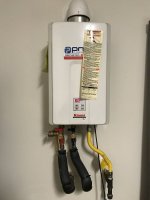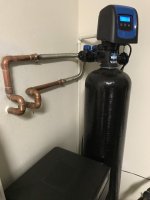takedownca
New Member
Hello. I'm a new homeowner and am planning to install a timed or flow sensor-triggered recirculating pump at my water heater as well as sensor bypass valves under my kitchen and bathroom sinks. But I have lots of questions/concerns about how this will affect my water softener.
I’ve attached a simple layout that I believe represents what my plumbing would look like with the pump installed. Hopefully it helps clarify my convoluted ramblings.
Thanks for any insight. I’m just trying to avoid making any unplanned plumbing mistakes.





I’ve attached a simple layout that I believe represents what my plumbing would look like with the pump installed. Hopefully it helps clarify my convoluted ramblings.
- When I moved in, the builder told me that the kitchen water is not softened. However, I see only one pair of in/out at the water heater. Am I right in assuming that only the cold kitchen water is hard, but the hot kitchen water is soft?
- If I put a sensor valve under the kitchen sink, am I now sending hot soft water back through the softener? Is that a problem for my water softener, or am I just going to run through softener salt a little faster?
- I could be wrong, but I don't believe there is a check valve after the water softener. Does that mean hot soft water will circulate backwards through the softener or somehow hamper the venturi flow? Is a check valve necessary?
Thanks for any insight. I’m just trying to avoid making any unplanned plumbing mistakes.




Last edited:
